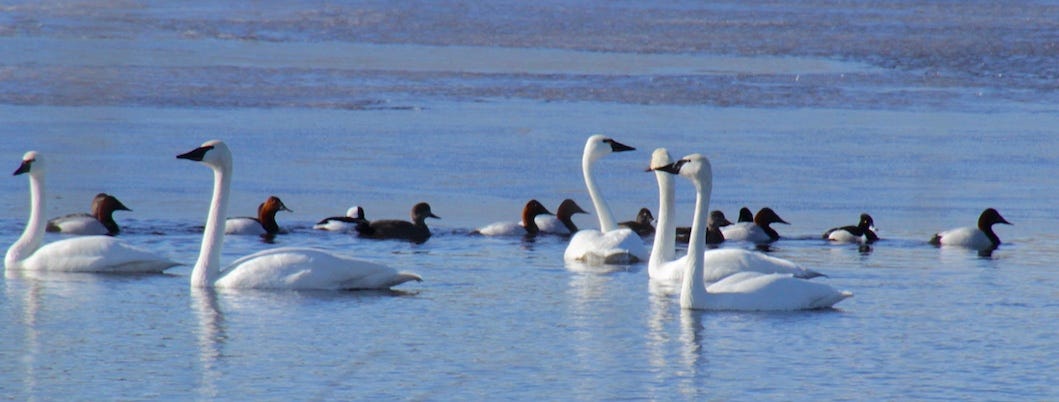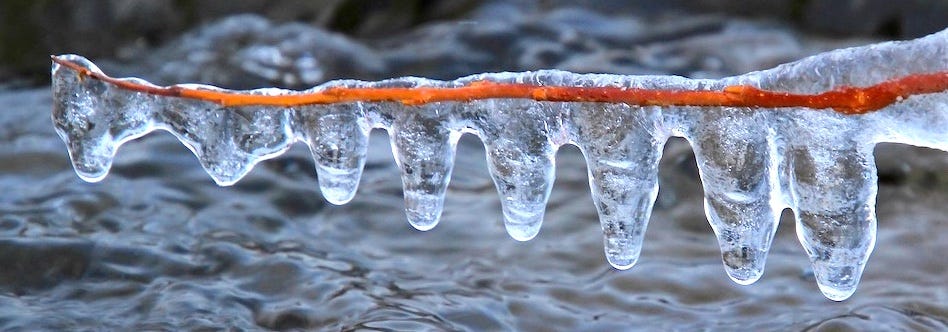Snow on ancient lava flow (basalt) in Upper Grand Coulee
How I got to Spokane, and a prayer for General Milley
Forty five years ago I woke up in downtown Ellensburg to quickly learn from the radio that people who had to work outside should protect themselves from frostbite. It was January 30, 1980. Among the details I remember is that a reliable thermometer in a place called the “Badger Pocket” (a small valley a few miles southeast of town) recorded the coldest temperature in the continental United States for that day. ~30 below zero F.
Five months earlier I’d been hired as a reporter for the Ellensburg Daily Record, the smallest daily in Washington state. I was primarily a police reporter but was also assigned to cover City Hall, the Ellensburg School Board, the Kittitas County Commission and, on Friday nights in the fall, high school football. By January of 1980 I was also in charge of the paper’s dark room. It made for some long days and nights.
On this bitter cold day, the police scanner buzzed with the outbreak of a fire. It was just a couple blocks away, at Third & Pearl—the Webster Hotel. The hotel was not really a hotel any more but rather a home to low-income folks ranging from students at nearby Central Washington University, to young families and several elderly residents. I raced there on foot with a camera and a notebook, and arrived as smoke was billowing from the lower floors. Several of the residents were still evacuating, some carrying armloads of belongings out into the freezing air, walking through the clouds of their breath as they came into the sunlight.
There but for the grace of God go I, I was thinking. I was still poor at the time: no car, no boots and not the best of gloves. My feet were quickly numb and the camera—a newspaper-issued Rolleiflex that used large-format film—was disabled by the cold. It simply wouldn’t work. Too bad because the scene was surreal. The fire that started on the ground floor quickly spread to the top floor, the fourth.
The firefighters were amazing. The water coming from their hoses was freezing in a matter of seconds. It would leave their hoses as water going up toward the top of the building, but the plume would become snow at its apex and return to the ground in that form. You could watch that happen in real time. My mouth was open in awe. I remember making eye contact with a young fireman aiming one of the hoses. He managed a half-smile and shook his head. If you’ve been near a big fire like this you never forget the pungent, toxic clouds it produces. It smells like death and sadness and by the time I left to walk back to the newsroom and write my story, the odor was deeply into the three sweaters I was wearing.
I didn’t last long in Ellensburg. I had been assured that I would be free to do investigative reporting when I took the job. But that assurance was untrue, and perhaps I should have known better. Not long after the fire a social worker tipped me off to a dire circumstance at another low-income project, a former motel on the west side of town. I did what reporters do, but the out-of-town landlord wouldn’t talk to me. What I had were the testimonies of social workers, residents, the local utility. But my story was spiked by the publisher (also the editor at the time) who said it may invite a libel suit that the paper would have to defend, and that could be costly.
I was furious. But I stayed.
A few weeks later I learned from a source in the sheriff’s office that the county fire marshal was being investigated for arson. (He’d burned down his house to collect the insurance). I called the fire marshall. He confirmed it. I wrote the story. It, too, was spiked.
“It’s libelous,” the publisher told me. “But he’s the source,” I protested, explaining my story was libel-proof given that the Supreme Court had ruled (New York Times v. Sullivan, 1964) that truth is a defense for libel and, in order to prove libel—under the Supreme Court’s standard— a public official would have to show that I had knowledge of falsity or was exercising “reckless disregard for the truth.”
“But he [the fire marshal] confirmed it,” I protested, again.
“It’s libelous,” my editor repeated.
A few days later, one of the Seattle papers learned about the story (not from me) and, for obvious reasons, reported it as a major scoop. That was salt in the wound for sure.
It was spring by then, and ash from the recent eruptions of Mt. St. Helens was everywhere. I resigned my newspaper job in protest and moved to Spokane, driving east in a Ford Galaxy that belched ash from the air ducts.
The missing portrait
This is such a bizarre and weird time to be an American. There is something like a wave of insanity rippling through our social and political culture, and it comes served with a side-dish of thuggery, to intimidate critics, whistleblowers and even millionaires who aren’t sufficiently supportive of the new-again president with either fealty or money.
Here’s a prediction though. History will be kind to recently retired General Mark Milley. Milley, you may remember, is the former Chairman of the Joint Chiefs of Staff who has been bitterly critical of Trump, telling journalist Bob Woodward, for the record, that Trump “is fascist to the core” and “the most dangerous person to this country.”
Among the conflicts with Trump that Milley was forced to endure involved Trump’s plea to Milley to use American soldier to “crack their skulls!” and shoot at the legs protesting U.S. citizens. Milley’s steadfast opposition to using U.S. troops against Americans and his statements to Woodward about Trump have made him a high-priority target for the new administration.
Milley’s portrait—honoring his service as head of the Joint Chiefs—was removed from the Pentagon just hours after Trump took the oath of office. It is now being reported, by the Washington Post and other news outlets, that the new Secretary of Defense, former Fox News host Pete Hegseth, has suspended Milley’s security clearance, canceled his security detail, and ordered an inspector general’s investigation into Milley’s conduct. The investigation could lead to Milley being demoted, even in retirement. President Trump has been less than subtle about his anger with the retired general. In 2023 The Atlantic reported Trump had suggested Milley be tried and executed for treason.
In response to Trump’s threats against Milley, former President Biden issued a pre-emptive pardon for the general on Jan. 20th.
Today’s edition is free to all readers, but please consider supporting The Daily Rhubarb with a paid subscription at the link above. tx, tc
The new Secretary’s first day
Finally, I hesitate to share this surreal video (courtesy of the Bulwark) but especially if you’re an American, you really should watch this. It’s an 18 minute compression from Tuesday, the first White House press briefing hosted by a 27 year-old former Fox News intern by the name of Karoline Leavitt, a devout Catholic and long-time MAGA supporter. She is the new White House Press Secretary.
I recently shared a near fifty year old memory of being at right-wing rally in the Palouse, where the opening ceremony was led and highlighted by a hyper-patriotic ingenue, sashed in stars & stripes, performing song and dance in advance of one of the most disgustingly racist talks I’ve ever heard. That reminded me of this, seeing young Ms. Leavitt with a gold crucifix on her blouse, opening with pleasantries before glowingly extolling Trump and repeatedly trolling the assembled press corps. I’m so glad I wasn’t there. I fear would have done what Iraqi journalist Muntadhar al-Zaidi did at a 2008 press conference when he threw both his shoes at then-President George W. Bush. But, hey, draw your own conclusions.
p.s. For all her energy and self-confidence Ms. Leavitt really did complicate things for her boss and his lawyers, who were trying to assure a federal judge that an arguably illegal memo sent to all fifty states had been withdrawn. TPM’s David Kurtz has a summary of that fiasco—amidst Ms. Leavitt’s notorious first day on the job—here.
—tjc










